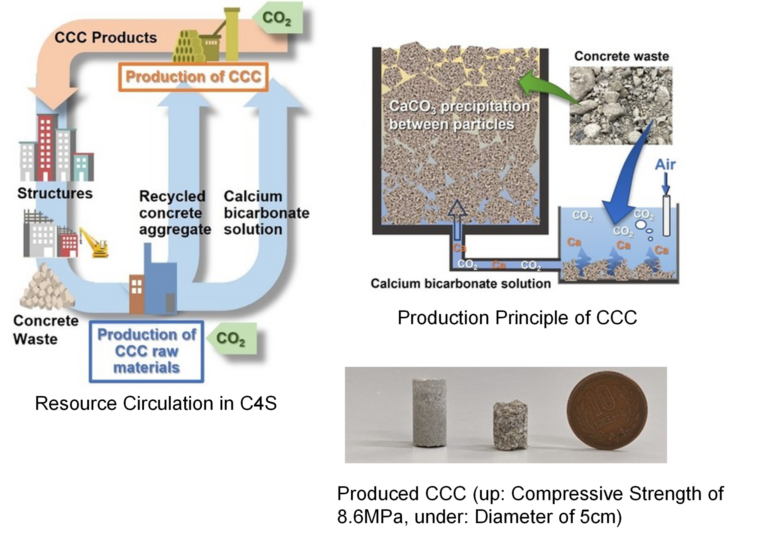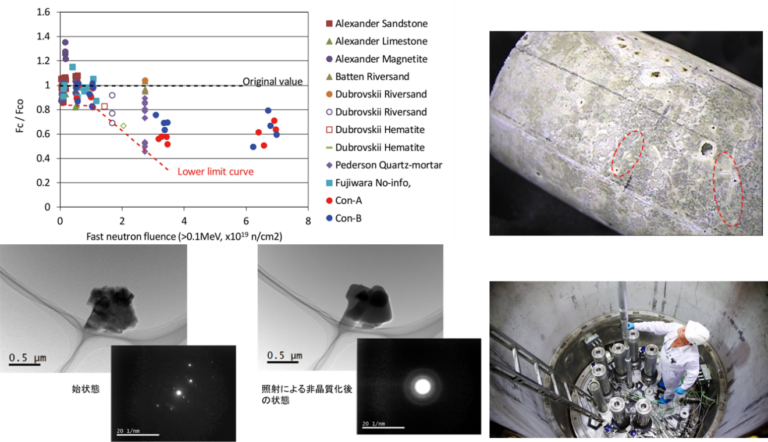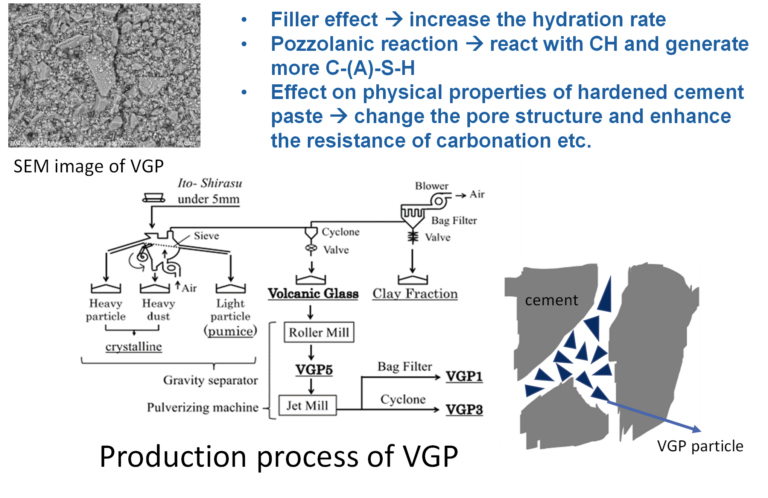Maruyama Lab
Contribution to the carbon neutral and sustainable architectural buildings and construction industries though material science and structural engineering
Research Theme
In this era of maintenance and preservation, scientific research has become more and more important than engineering research. Understanding the chemical and physical properties of materials, evaluating the time-dependent changes of materials accordingly, and predicting the performance over a period of 100 years or more is necessary. We are developing new construction materials, developing new recycling loops, proposing solutions to existing and future problems, elucidating the mechanisms of material function, by conducting research on materials design in extreme environments, materials development based on natural phenomena, maintenance and conservation of historical structures, and multi-scale performance evaluation of cementitious materials. We are also developing human resources who can contribute to a sustainable society.
Project
C4S research & development project (Moonshot Research and Development Program/Realization of sustainable resource circulation to recover the global environment by 2050, NEDO)
Related Organization: The University of Tokyo, Hokkaido University, Tokyo University of Science, Kogakuin University Shinjuku Campus, Utsunomiya university, Shimizu Corporation, Taiheiyo Cement, Masuo Recycle Corporation
Cement concrete is an indispensable construction material for social capital development, but its production uses a large amount of limestone, which is a finite natural resource, and emits a large amount of CO2. The ratio of limestone reserves to production is about 100 years, and about 7% of 33 billion tons of CO2 emitted
annually worldwide comes from cement production. To fundamentally solve the problems of resource depletion and CO2 emission, in “C4S Research and Development Project”, Ca in cement concrete of buildings and civil structures is regarded as a potential resource capable of capturing CO2, and a technology is being developed to regenerate concrete waste generated by the demolition of buildings and civil structures and atmospheric CO2 as calcium carbonate concrete (CCC), which will be put into practical use as a main construction material to replace current cement concrete. Consequently, a new resource recycling system (C4S: Calcium carbonate circulation system for construction) will be realized.

Development of method for evaluation of concrete transformation and RC member soundness under radiation environment (Research and Development of Technology for Nuclear Safety, Agency for Natural Resources and Energy)
Related Organization: Mitsubishi Research Institute, Nagoya University, The University of Tokyo, Kajima Construction company, Nuclear Physics Institute of the Czech Academy of Sciences Research institute, Chiba University, Nagaoka University of Technology, MRI Research Associates
Regarding the measures for aging light-water reactor plants that have operated for more than 30 years up to 60 years, we aim to clarify the mechanism of deterioration due to the effects of radiation irradiation on reactor concrete structures that are difficult to replace and, and to gain technical insights to determine if it is possible continue safe operation.
At the same time, we will develop basic data and standard evaluation methods that can be referred to and utilized by some light-water reactors in Japan, and contribute to the development of a common infrastructure for improving nuclear safety. This work will make it possible to efficiently long-term operation of nuclear power plants.

図1 照射量と強度の関係(左上),照射後のコンクリート(右上),原子炉で照射する様子(右下),電子線で照射した石英の変質(左下)Figure 1 Relationship between irradiation value and strength (upper left), concrete after irradiation (upper right), irradiation in a nuclear reactor (lower right), alteration of quartz irradiated by electron beams (lower left) 
図2 マルチスケールで考慮する鉄筋コンクリート部材の性能評価システム Figure 2 Multi-scale performance evaluation system for reinforced concrete members
Quantitative evaluation of long-term status change of deteriorated reinforced concrete for rational disposal considering actual environment
(Project to Promote Nuclear Science and Technology and Human Resource Development by Concentrating Wisdom, Problem-solving Nuclear Decommissioning Research Program, MEXT)
Related Organization: The University of Tokyo, National Institute for Environmental Studies, Taiheiyo Consultant, Taiheiyo Cement, Nagoya University, Hokkaido University, Japan Atomic Energy Agency
In the decommissioning of the Fukushima Daiichi Nuclear Power Plant, understanding the contamination status of radioactive materials in concrete members (internal concentration distribution and total amount) is necessary for decontamination, selection of dismantling methods, and disposal after dismantling. Conventionally, the behavior of cations in concrete has not been clarified, and in addition, there are many complicated factors such as the interaction with seawater, the aging of concrete, and the effects of high temperature changes due to heat generation in nuclear reactors. The purpose of this study is to develop a method to estimate the contamination status of reactor structures by predicting material penetration based on this fundamental information.

Research and development on standardization of CO2 fixation evaluation in concrete
(Technical development of quality control and fixation fee evaluation method for CO2 emission reduction and fixation maximization concrete – Green Innovation Fund Project)
Related Organization: The University of Tokyo, Taiheiyo Consultant, Chiba University, University of The Ryukyus, Hiroshima University, Hokkaido University
Currently, CO2 fixation is being discussed in various types of concrete. Conventional cement production usually emits a large amount of CO2 due to the decomposition of limestone, therefore the concrete industry is responsible for a certain amount of CO2 emissions, and new types of concrete are being considered. In these developments, it is necessary to standardize the evaluation method in order to establish a healthy market. In this research and development, we will develop an evaluation method for JIS/ISO and prepare the data that contributes to it.

Impact projection and evaluation of climate change adaptation measures for sustainable urban built environment
(The S-18’s Comprehensive Research on Projection of Climate Change Impacts and Evaluation of Adaptation)
Related Organization: Nagoya University, The University of Tokyo
Based on climate change adaptation scenarios, supportive information for the discussion of adaptation plans and measures for buildings and infrastructure facilities will be provided in this study. First, we will analyze and model the stock and flow of buildings and infrastructure facilities (roads, water, sewage, etc.) for Japan, and then examine the impacts of different climate change adaptation scenarios based on spatial information. In order to examine this at the city level, urban structure level, and construction material level, the impact of adaptation scenarios for buildings and infrastructure facilities will be conducted. From a multifaceted perspective of urban material cycling, energy, construction materials, urban meteorological phenomena, and urban economy, we will consider and further discuss strengthening urban functions and the possible impact on carbon emissions, lifetime change and its impact on opportunities for new technology introduction and increasing building and infrastructure stock that is vulnerable to climate change.
Research topics
Prediction of corrosion rate of steel bars in carbonated reinforced concrete members and proposal of soundness assessment method
By clarifying the effects of internal and environmental factors on the corrosion of reinforcing steel bar in carbonated concrete, the hypothesis of steel corrosion controlling mechanism in cementitious materials under different environmental conditions can be proposed based on electrochemical principles. Based on the experimental data and proposed hypothesis of the corrosion mechanism, the corrosion rate of steel bars in carbonated concrete will be quantified to determine the amount of corrosion products in the structure. Furthermore, we aim to propose a method to evaluate the soundness of reinforced concrete members.

Prediction of CO2 absorption during lifecycle of cement in Japan
Since cement is a major source of CO2 emissions in the construction field, it is necessary to accurately identify the CO2 amount of the cement industry for efficient emission reduction. The CO2 uptake in Japan is calculated by a coupled model related with the stock and demolition of concrete. By focusing on the different internal moisture state in the specimen during the natural and accelerated carbonation test, and on supplementary cementitious materials with variable CH amount and Ca/Si of C-S-H, we will propose an appropriate method to covert the carbonation depth from accelerated carbonation to natural carbonation environment, which contribute to the prediction accuracy of future CO2 uptake.

Impact of VGP on hydration and strength development in VGP-cement system
In the field of building material, using supplementary cementitious materials (SCMs) to replace part of cement is a good strategy to decrease the CO2 emissions. Volcanic glass powder (VGP), acting as a sustainable material, is one of the new kinds of SCMs, which comes from natural volcanic activities. By studying the physical properties of concrete and mortar containing Volcanic glass powder (VGP), the effect of VGP on the cement hydration on the cement can be clarified.

Control of curing reaction of hardened cement paste powder by precipitation of Calcium Carbonate
The concrete waste powder can be hardened by making CaCO3 precipitate between particles, which contributes to create the carbon neutral material cycle system which starts from concrete waste.

A proposal for a new building composite using magnesium carbonate on Mars
In recent years, the exploration of Mars has been expanding, with NASA’s plan announced in 2015 targeting a manned mission to Mars in the 2030s, with the goal of spending several years on the Martian surface.
Expectations are also rising in the construction field in recent years. Because the environment on Mars is different from that on Earth, various performance requirements are necessary. Since the solubility of carbonates changes depending on its temperature, we will propose a new building material using only locally available resources, using the mechanism of carbonate precipitation.



